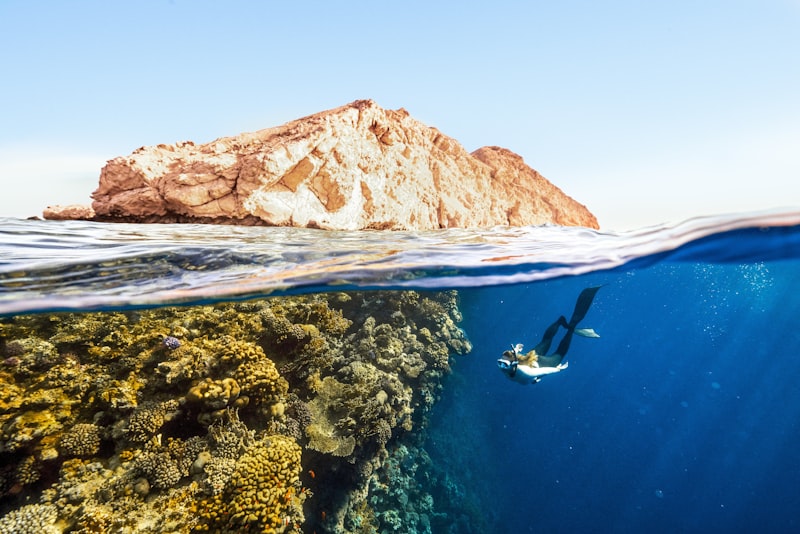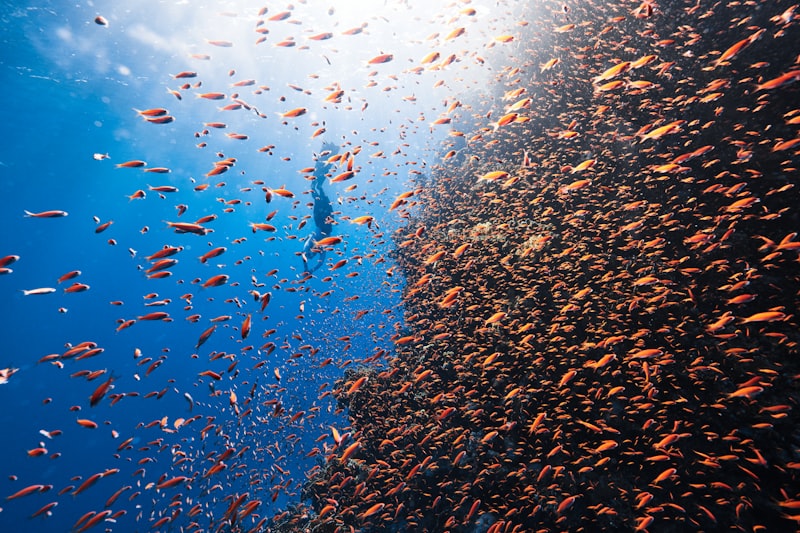Have you ever wondered about the intricate web of life beneath the ocean’s surface? Coral reefs, often called the rainforests of the sea, are not only visually stunning but also play a crucial role in marine ecosystems worldwide. Understanding their molecular ecology provides us with deeper insights into how these vibrant ecosystems function and how we can protect them.
At its core, molecular ecology delves into the genetic diversity, population structure, and evolutionary relationships of organisms within their environment. When applied to coral reefs, this field uncovers a wealth of information. Researchers analyze the genetic makeup of coral species, their interactions with symbiotic organisms like algae, and their adaptive responses to environmental changes such as rising sea temperatures and ocean acidification.
One fascinating aspect of coral reef molecular ecology is studying how corals and their symbionts communicate. Corals rely on a delicate balance with algae called zooxanthellae, which provide them with essential nutrients through photosynthesis. The genetic exchanges between corals and these algae are pivotal in understanding reef resilience to stressors like bleaching events.
Moreover, molecular techniques help scientists track the movement of coral larvae across reefs, which aids in conservation efforts and understanding population dynamics. By identifying key genes related to stress tolerance or disease resistance, researchers can pinpoint which coral populations are more resilient and should be prioritized for conservation.
The study of molecular ecology in coral reefs is not just about unraveling scientific mysteries but also about safeguarding these biodiversity hotspots for future generations. Through advanced genetic analyses and innovative research methods, scientists continue to deepen our understanding of how these underwater wonders thrive and adapt in a changing world.
Unveiling the Genetic Secrets: Exploring the Molecular Diversity of Coral Reefs
Coral reefs, often referred to as the “rainforests of the sea,” host an astonishing variety of life forms, each intricately connected through their genetic makeup. The study of coral reefs’ molecular diversity reveals a tapestry of adaptations and evolutionary marvels that have developed over millennia. From the vibrant Great Barrier Reef to the lesser-known reefs of the Caribbean, each ecosystem harbors unique genetic signatures waiting to be explored.

Imagine these reefs as bustling cities, where each coral species plays a specific role, interacting with its neighbors in complex ways. The genetic diversity within these species is akin to a library of survival strategies, where genes adapt to changing oceanic conditions, from temperature fluctuations to ocean acidification.
Scientists delve into the genetic codes of coral reefs not only to understand their resilience but also to unlock potential solutions for environmental challenges. Like keys to a treasure trove, these genetic secrets hold promise for future medical treatments, biotechnological innovations, and strategies for conservation.
As we peer into the molecular world of coral reefs, we marvel at the intricacies shaped by natural selection. Each gene, like a protagonist in a story, contributes to the resilience and beauty of these underwater ecosystems. The diversity encoded within their DNA is a testament to nature’s creativity and adaptability, urging us to cherish and protect these fragile yet resilient habitats.
From Genes to Ecosystems: How Molecular Ecology Shapes Coral Reef Health
Coral reefs, often called the “rainforests of the sea,” host a staggering array of life forms, from vibrant fish to microscopic algae. Yet, their health hinges on a molecular symphony played out over generations. Genes encode traits that determine an organism’s ability to withstand environmental stressors, such as rising ocean temperatures or pollution. Through processes like natural selection, these genetic adaptations can sculpt populations over time, fostering resilience or vulnerability.
Molecular ecologists delve into the genetic blueprints of coral and their symbiotic partners, such as zooxanthellae, to unravel these adaptive strategies. They study how specific genes enable corals to thrive in nutrient-poor waters or resist bleaching events triggered by climate change. This understanding is crucial for predicting and mitigating the impacts of human activities on reef ecosystems.
Beyond individual species, molecular ecology reveals the intricate web of interactions that sustains entire reef communities. Genetic markers trace the flow of nutrients and pollutants through ecosystems, shedding light on how human interventions ripple through marine habitats. By mapping these molecular landscapes, researchers can advocate for conservation strategies that safeguard biodiversity and ecosystem services.
In essence, molecular ecology illuminates the invisible threads that bind genes to ecosystems. It invites us to marvel at nature’s resilience and underscores our role as stewards of the oceans. As we navigate a changing climate and global challenges, this scientific discipline offers hope and a roadmap for preserving the kaleidoscopic beauty and vital services of coral reefs for future generations.
Cracking the Code: Molecular Insights into Coral Adaptation and Resilience
Coral reefs, often called the “rainforests of the sea,” are marvels of nature’s resilience and adaptation. These vibrant ecosystems teem with life, supporting a diverse array of marine species. Yet, they face unprecedented challenges due to climate change and human activities.
At the forefront of coral survival lies a fascinating realm of molecular biology. Scientists are delving deep into the genetic codes of corals, unraveling how these organisms cope with environmental stressors such as rising sea temperatures and ocean acidification. It’s akin to deciphering a complex puzzle, where each gene holds clues to coral resilience.
One key area of study is the symbiotic relationship between corals and tiny algae called zooxanthellae. These algae live within coral tissues and provide them with essential nutrients through photosynthesis. Understanding the genetic mechanisms that regulate this symbiosis is crucial. It’s like uncovering the intricate dance between partners in a lifelong partnership.
Moreover, researchers are investigating how corals can switch their metabolic pathways in response to stress. Imagine corals as adaptable chefs in a kitchen, altering their recipes based on changing ingredients. By studying these metabolic shifts at the molecular level, scientists gain insights into how corals manage to survive and even thrive in challenging conditions.
Another breakthrough area is epigenetics, the study of changes in gene activity that do not involve alterations to the genetic code itself. This field explores how environmental factors can influence which genes are turned on or off in corals. It’s like a switchboard where external signals determine which lights illuminate – a crucial aspect in understanding coral adaptability.
The Invisible Guardians: Molecular Players in Coral Reef Conservation
One such molecular player is the zooxanthellae, a type of algae that lives symbiotically within coral polyps. These algae are like miniature solar panels, harnessing the sun’s energy through photosynthesis and providing essential nutrients to their coral hosts. This relationship is not just beneficial but vital for coral reefs, as it allows them to thrive in nutrient-poor tropical waters where they form the foundation of diverse marine ecosystems.
Another key player in this invisible army is the coral’s immune system. Yes, corals have immune systems too! Just like our own bodies, corals have defense mechanisms against pathogens that could otherwise harm them. These molecular defenses help corals resist diseases and recover from stressors like rising sea temperatures and pollution.
But the challenges facing coral reefs today are immense. Climate change, ocean acidification, and overfishing threaten their very existence. These issues don’t just affect corals on a visible level—they disrupt the delicate molecular balance that supports coral health.
Researchers are now delving into the molecular world of corals to understand how these tiny players respond to environmental stressors. By studying the genes, proteins, and biochemical pathways involved, scientists hope to unlock new strategies for coral reef conservation. Imagine if we could bolster coral resilience by enhancing their molecular defenses or by restoring beneficial symbiotic relationships.
In essence, the unseen molecular guardians of coral reefs are not just passive spectators—they are active participants in the fight for reef survival. Their roles are complex, interconnected, and essential for maintaining the vibrant ecosystems that millions of species depend on.
DNA Deep Dive: Mapping the Molecular Landscape of Threatened Coral Species
Imagine coral DNA as a treasure trove of information, each strand a roadmap telling tales of adaptation and evolution. Like detectives of the sea, researchers meticulously map these molecular landscapes to uncover the resilience strategies ingrained in coral genomes. From the vibrant hues of the Great Barrier Reef to the depths of the Caribbean, every coral species carries a unique genetic fingerprint shaped by centuries of environmental pressures.
But why delve into the molecular realm? The answer lies in conservation. As coral reefs face unprecedented threats from climate change, pollution, and habitat destruction, understanding their genetic diversity becomes critical. It’s akin to understanding a complex puzzle where each piece—the genes—holds a clue to ensuring their survival amidst adversity.
Through advanced genomic technologies, scientists can now identify genes responsible for heat tolerance, disease resistance, and adaptation to changing ocean conditions. It’s not just about preserving corals as they are but equipping them with genetic resilience to thrive in a rapidly changing world.
Think of coral DNA as a storybook of adaptation, where chapters unfold with revelations about their ability to withstand stressors that would otherwise prove fatal. The molecular insights gained from these studies aren’t just confined to laboratories; they pave the way for innovative conservation strategies, where science meets stewardship on the frontline of ocean preservation.
Survival Strategies Unveiled: Molecular Ecology’s Role in Coral Reef Evolution
Have you ever wondered how coral reefs, those breathtaking underwater cities of biodiversity, manage to adapt and survive in a changing environment? The secret lies in the fascinating world of molecular ecology. This field of study delves deep into the genetic makeup of organisms and their interactions with the environment, offering crucial insights into coral reef evolution.
At its core, molecular ecology examines how genetic diversity influences the resilience of coral species against stressors like climate change and human impact. Imagine each coral polyp as a tiny but resilient unit equipped with its own genetic toolkit. These tools aren’t just random; they’re finely tuned over generations to cope with specific environmental challenges.

Analogous to a skilled artisan refining their craft over years, coral reefs evolve through molecular mechanisms that allow them to adapt to warmer waters, pollution, and other threats. It’s a survival dance where genetic variation plays the lead role. Through DNA analysis and population genetics, scientists can uncover the intricate patterns of adaptation that enable coral reefs to thrive amidst adversity.
Picture coral reefs as bustling cities where every resident (each species) plays a vital role in the community’s resilience. Just like humans, corals have evolved strategies—albeit molecular ones—to weather storms, bleaching events, and habitat degradation. By decoding these molecular strategies, researchers not only unravel the past but also pave the way for future conservation efforts.
In essence, molecular ecology doesn’t just study corals; it tells the story of resilience, adaptation, and survival in one of Earth’s most fragile yet resilient ecosystems. Understanding these molecular intricacies is key to protecting coral reefs for generations to come.
Beyond the Surface: Molecular Tools Revolutionizing Coral Reef Management
Imagine these molecular tools as tiny, powerful agents working behind the scenes to decode and address the challenges facing coral reefs. One such tool is DNA barcoding, a technique borrowed from genetics research. It allows researchers to identify coral species with precision, even distinguishing between closely related species that look identical to the naked eye. This capability is crucial for monitoring biodiversity changes in reefs over time and assessing the effectiveness of conservation efforts.
Another cutting-edge tool in the arsenal is environmental DNA (eDNA) analysis. Think of it as detective work for the seas. By collecting and analyzing fragments of genetic material shed by organisms into their environment, scientists can uncover a wealth of information without disturbing the delicate reef ecosystems. This non-invasive approach provides insights into the presence of rare or elusive species, offering a more comprehensive understanding of reef biodiversity.
Furthermore, RNA sequencing technology plays a pivotal role in deciphering how corals respond to stressors such as rising sea temperatures and ocean acidification. By studying the gene expression patterns within corals, researchers can pinpoint genes that enable certain species to withstand environmental changes better than others. This knowledge is invaluable for guiding selective breeding programs aimed at developing more resilient coral varieties.
Beyond individual species, these molecular tools also enhance our ability to monitor overall reef health. For instance, microbial community analysis through metagenomics reveals the intricate relationships between corals and their associated microorganisms. Understanding these dynamics helps predict coral bleaching events and disease outbreaks, allowing for timely intervention strategies.
Frequently Asked Questions
How do scientists use genetic markers to study coral reef ecosystems?
Discover how scientists utilize genetic markers to study coral reef ecosystems, exploring genetic diversity, population structure, and responses to environmental changes.
How does coral bleaching affect genetic diversity in reef-building corals?
Learn how coral bleaching impacts genetic diversity in reef-building corals. Discover the consequences of bleaching events on genetic resilience and adaptation in coral populations.
What are the main threats to coral reefs identified through molecular ecology?
Discover the primary threats to coral reefs as identified by molecular ecology, offering insights into the specific stressors affecting coral health and ecosystem resilience.
What is molecular ecology and how does it apply to coral reefs?
Molecular ecology examines genetic diversity, interactions, and adaptations of organisms in their natural environments. In coral reefs, it helps understand how genetic factors influence resilience to environmental stressors, population dynamics, and species interactions. By studying DNA markers and genetic variation, researchers can assess coral health, response to climate change, and inform conservation strategies.
What role do symbiotic relationships play in coral reef resilience according to molecular ecology?
Learn about the critical role of symbiotic relationships in coral reef resilience as explored through molecular ecology. Discover how these relationships impact the health and stability of coral ecosystems.


